
The Lifter's Sole: A Complete Guide to Powerlifting Shoes
In a sport decided by kilograms, every piece of equipment matters. While belts and sleeves get a lot of attention, the shoes on your feet are the foundation of every lift. They are your direct conneaction to the floor, responsible for stability and force transfer. Choosing the right footwear is a critical decision that can directly impact your technique, safety, and how much weight you can lift. This guide breaks down the different types of powerlifting shoes and helps you decide which sole is right for your soul.

Why Do Shoes Matter in Powerlifting?
Your shoes are more than just a fashion statement. They serve three primary functions:
-
Stability: A powerlifting shoe must have a hard, non-compressible sole. Running shoes, with their soft, cushioned soles, are terrible for lifting because they create an unstable surface, which is both unsafe and inefficient.
-
Force Transfer: The hard sole ensures that the force you generate with your legs is transferred directly into the ground and up through the bar, without being lost in the cushioning of the shoe.
-
Optimizing Biomechanics: Different shoes can alter your joint angles and body position to put you in a more advantageous and efficient position for a specific lift.
The Squat Shoe: The Power of the Heel
The most specialized piece of footwear is the weightlifting or squat shoe, easily identified by its signature raised heel.
-
Key Features:
-
Elevated Heel: Typically made of hard plastic (TPU) or wood, the heel is usually 0.75" to 1.0" high.
-
Hard, Flat Sole: Ensures maximum stability.
-
Metatarsal Strap: One or two straps across the midfoot to lock your foot in place.
-
-
The Benefits:
-
Improved Ankle Mobility: The raised heel decreases the demand on ankle dorsiflexion. For lifters with tight ankles, this is a game-changer, allowing them to squat deeper while maintaining an upright torso.
-
More Upright Torso: By allowing your knees to track further forward safely, the heel helps you keep your chest up, which is especially beneficial for high-bar squatters and those prone to pitching forward.
-
Greater Quad Activation: The more upright posture tends to place a greater emphasis on the quadriceps.
-
-
Who Should Use Them? Lifters with poor ankle mobility, high-bar squatters, or anyone who struggles with maintaining an upright torso will benefit most from a heeled shoe. They are the gold standard for a reason.

The Deadlift Shoe: Get Low, Pull Hard
For the deadlift, the goal is often the exact opposite of the squat: you want to be as close to the ground as possible to reduce the range of motion.
-
Key Features:
-
Ultra-Thin, Flat Sole: A very thin, hard rubber sole with no heel-to-toe drop.
-
Minimalist Design: Often a simple slipper or a very flat-soled shoe.
-
Ankle Support (Optional): Some deadlift shoes come in a high-top design for added ankle support.
-
-
The Benefits:
-
Reduced Range of Motion (ROM): Every millimeter less you have to pull the bar is an advantage. A thin sole lowers your starting position, effectively reducing the ROM.
-
Improved Stability and Balance: A flat sole allows you to spread your feet and "grip" the floor, improving balance, especially for sumo deadlifters.
-
Better Force Application: Puts you in a better position to engage your posterior chain.
-
-
Who Should Use Them? Almost any serious deadlifter, especially conventional pullers, will benefit from a flat shoe or slipper. For sumo pullers, the stability of a flat shoe is paramount.
The All-Rounder: Can One Shoe Rule Them All?
Many beginners and recreational lifters use a single pair of shoes for all three lifts, often a classic flat-soled trainer.
-
Common Examples: Converse Chuck Taylors, Vans, or other flat skate shoes.
-
Pros:
-
Affordable and Accessible.
-
Good for Deadlifts and Bench Press: The flat, hard sole is excellent for these lifts.
-
Serviceable for Squats: Better than running shoes, but they offer no help with ankle mobility.
-
-
Cons:
-
No Squat Advantage: They do not provide the benefits of a raised heel for the squat. If you have good mobility, this may not be an issue, but for many, it's a limiting factor.
-
Federation Rules and Making Your Choice
Most powerlifting federations, including the IPF, have rules about footwear (e.g., must have a sole, no part of the underside higher than 5cm). All the shoe types discussed here are generally legal for competition.
-
For the Beginner: Starting with an affordable all-rounder like Converse is a great option.
-
For the Aspiring Competitor: Investing in a dedicated squat shoe and a pair of deadlift slippers is a worthwhile upgrade that can have a direct impact on your performance.
-
For the Bench Press: Either shoe type works, as the primary requirement is a flat, stable sole to get leg drive. Many lifters simply wear their squat shoes for convenience.
Your shoes are the critical link between your body and the ground. Choosing the right footwear is a strategic decision that can improve your stability, optimize your lifting mechanics, and help you lift more weight safely. By understanding the specific benefits of heeled squat shoes and flat-soled deadlift shoes, you can make an informed choice to build your total from the ground up.
What shoes are in your gym bag? Let us know your preferred footwear in the comments!








